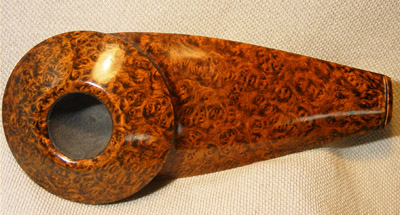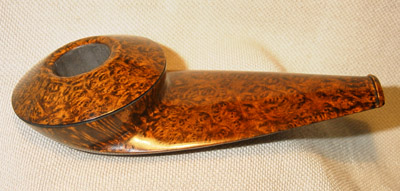Page 1 of 1
Posted: Fri Nov 12, 2004 3:57 pm
by Tyler
By cross grain, I take it you mean the growth rings that are defined when blasting?
If so, my answer is, I dunno.

Tyler
Posted: Fri Nov 12, 2004 4:40 pm
by jeff
Do you mean that the birdseye grain wasn't visible? If so, this clearly has less to do with a sanding
technique (if you mean by this that there is some secret swirl pattern or sequence of grits to use) and more to do with the fact that the pipe was most likely shaped before it was drilled. Although I can't speak to how this was done in particular, I can imagine that it was simply a really good job of following the grain and using angles to eliminate the birdseye. A good example would be Eltang's Ukelele, although he does the opposite, he removes the straight grain. You can see how the angles were chosen to eliminate the straight grain and only display birdseye.


Did I get at your question at all or just ramble?
Jeff
Posted: Fri Nov 12, 2004 7:16 pm
by RadDavis
Hi Random,
If you mean growth rings, like Tyler said, they usually mostly disappear after staining. I know of no technique to sand them out. I think that would be impossible.
Usually cross grain refers to the grain orientation on the stummel. It's still straight grain, but oriented to be horizontal rather than vertical, usually straight across the front and back with birdseye on the sides.
Di I help?
Rad
Posted: Sat Nov 13, 2004 4:33 pm
by KurtHuhn
Maybe I'm wierd, but I find the ring grain (aka growth rings) quite pleasing. I like it when that shows through.
Posted: Sat Nov 13, 2004 5:51 pm
by ToddJohnson
You can't eliminate growth rings anymore than you could eliminate straightgrain, crossgrain, or bird's eye. If it's there and visible (sometimes growth rings are decidedly less visible than at other times) you're going to see it when the pipe is finished. No amount of staining, sanding, use of geometry or hocus pocus will remove them. My advice would be, if you've got growth rings so pronounced that you somehow think they detract from the beauty of the pipe, blast the thing, or send it to somebody who can. Anytime I have a piece like this, I set it aside to be blasted. In my experience, the more visible and pronounced are the growth rings, the more likely you are to get a spectacular blast out of it.
Todd
Posted: Fri Nov 19, 2004 2:53 pm
by kbosi
now that is some nice birds eye
Posted: Fri Nov 19, 2004 10:08 pm
by ArtGuy
So, to accentuate growth rings, is the pipe blasted with or against the grain? Or does it matter. What I mean is.....
Was this pipe most likely blasted from the bottom towards the top or from the top down?

I should give credit where due, that wonderfull blast was done by our very own Jack Howell.
Posted: Fri Nov 19, 2004 10:54 pm
by KurtHuhn
Holy friggen moly! That's a wonderful blast, Jack!
Posted: Sat Nov 20, 2004 8:57 am
by JHowell
Thanks, I hardly expected one of my pipes to show up as an example of a blast -- that's quite a compliment. I find that blasting "top down" emphasizes the growth rings a little more, while blasting bottom up emphasizes the striations and blasting across the striations helps develop that "peaky" Cooke-like look, but that could be my imagination. What really matters (and I haven't gotten anywhere near Jim Cooke or Trever in the extremity of sharpness) is the right pressure. Too much and you blast away detail; too little and you sit there forever. I tend to go higher than the 80 psi Todd recommended, but I have a little clapped-out Harbor Freight cabinet that is probably pretty inefficient.
Posted: Sat Nov 20, 2004 3:06 pm
by ToddJohnson
JHowell wrote:Thanks, I hardly expected one of my pipes to show up as an example of a blast -- that's quite a compliment. I find that blasting "top down" emphasizes the growth rings a little more, while blasting bottom up emphasizes the striations and blasting across the striations helps develop that "peaky" Cooke-like look, but that could be my imagination. What really matters (and I haven't gotten anywhere near Jim Cooke or Trever in the extremity of sharpness) is the right pressure. Too much and you blast away detail; too little and you sit there forever. I tend to go higher than the 80 psi Todd recommended, but I have a little clapped-out Harbor Freight cabinet that is probably pretty inefficient.
I looked at the pipe on your site, and that's a
beautiful pipe, not just a great blast. Keep up the good work.
Todd
Posted: Sat Nov 20, 2004 9:32 pm
by Nick
WOW!@!!!



